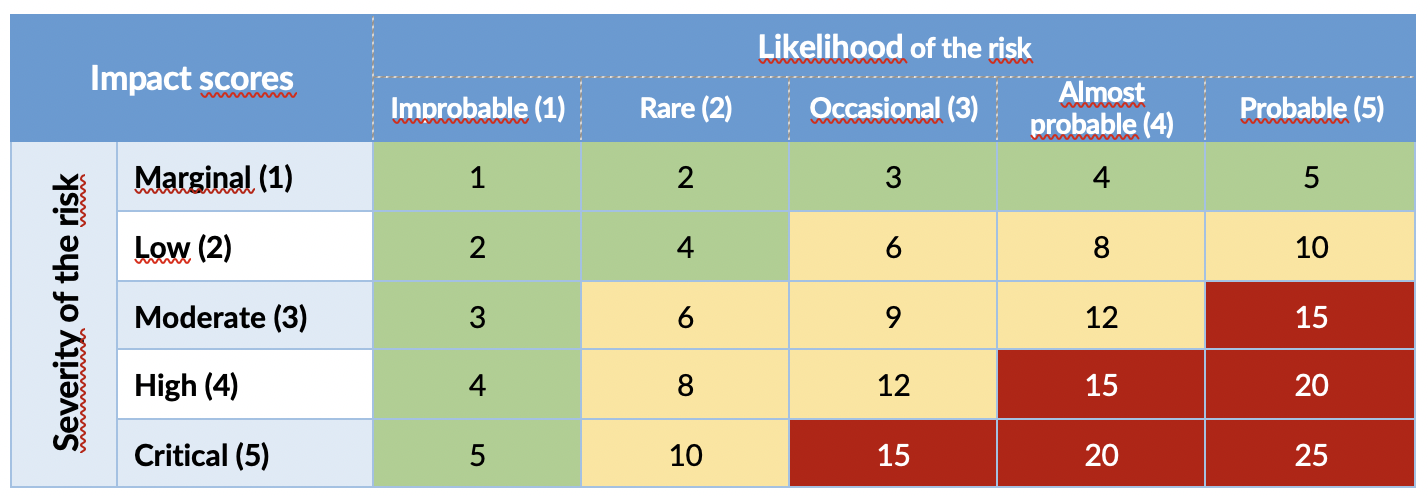The risks and risks categories assessment card is a tool designed to help decision-makers with the assessment of the risks of the adoption of disruptive technology in public administration for different stakeholders. The tool tries to provide a simple way of assessing the probability of a risk occurring and estimating its potential impact (the magnitude of damages it can cause).
Stage of adoption:
- Ante-adoption,
- Development
- Post-adoption
Roles:
- Overseeing roles,
- Technical Roles,
- Engaging roles
Methodology
- Team: 8-10 members (with multi-disciplinary backgrounds)
- Duration: 30 -45 minutes
- Materials: Template matrix for risk assessment, A step-by-step guide
Assessment scales
The assessment aim is to understand how significant the different risks and risk categories are for an ethical adoption of disruptive technologies in public administrations. In the case of risks, two aspects are assessed: the probability of the risk to happen ("likelihood") and the damage the risk will produce if occurring ("severity").
Assessment scale for likelihood
The risk is unlikely to occur during standard operations, but its probability of occurrence is not null. The probability associated with this risk is less than 5%.
The risk is likely to occur during standard operations, but its probability of happening remains low, ranging between 5% and 10%
The risk is possible to occur some times during standard operations, but its frequency remains moderate. The probability of this risk happening is ranging between 10% and 25%.
The risk is likely to occur during standard operations, and its frequency is relatively high; the probability of this risk ranges from 25% up to 50% (without exceeding it).
The risk is likely to occur often during standard operations; the probability level of the risk is over 50%.
Assessment scale for severity
The risk may either be controlled or would frequently result in less than minor, illness, injury or system damage.
The risk may either be controlled through mitigation actions or would commonly result in minor, illness, injury or system damage
The risk may often cause severe injury or illness or major system damage, requiring immediate corrective action.
The risk may cause severe injury or illness or major system damage, requiring immediate corrective action or even the immediate cessation of the unsafe activity or operation.
The risk may probably cause death or major system loss, requiring immediate cessation of the unsafe activity or operation.
Using the above scores, for each risk an overall impact score could be calculated by multiplying the likelihood score with the severity one. Using the table below, each risk can be assessed based on its score as high risk (if its overall impact is above 15), medium risk (the overall score is between 6 and 12) and low risk (the overall impact is 5 or less).
Assessment grid for the overall impact (bases on likelihood and severity scores)

The overall impact score assessment:
-
High risks (in red) have impact scores between 15 and 25;
-
Medium risks (in light gold) have impact scores between 6 and 12;
-
Low risks (in green) have impact scores between 1 and 5.
Step-by-step assessment
- The team members identifies and evaluates the likelihood and severtity of each of the risks (based on the type of DT adopted).
- The impact scores are calculated for each of the risks assessed.
- An overall impact score is estimated for each risk category (using the impact scores calculated for the risks included in the respective risk category). The impact score can be computed as the unweighted average of the impact scores of the risks included in the risk category.
- After obtaining all the impact scores for the risk categories, the team computes the weights associated with each risk category. The risk category's weight helps the team prioritise the risks for mitigation.
- The weights obtained will be uploaded in the ETAPAS prototype platform for the next assessment phase - the identification and selection of the mitigation indicators.
The overall assessment of risk helps prioritise their treatment; that does not mean that low risk should be ignored - they should just have a slightly lower priority in dealing with it. During the different stages of the DT adoption process, the risks' overall impact might change due to mitigation actions implemented or the identification of additional factors unaccounted before.

